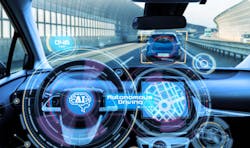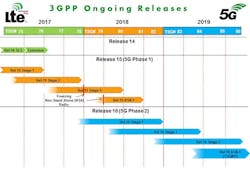“Can you hear me now?” I think many of us can remember Verizon’s well-known advertising campaign from a few years ago. While communication is fundamental to nearly every professional interaction, it has also become increasingly vital to nearly every technological evolution currently in motion—5G, autonomous vehicles, smart cities, and some that haven’t even been identified as of yet.
But for the sake of this blog, let’s focus on how communication is impacting the automotive industry. Most experts agree that the connected car isn’t required to achieve autonomous driving, but the potential benefits are undeniable. With CES 2019 just around the corner, let’s recap the progress that we’ve seen in the V2X space this year and look forward to what treasures January might bring.
When I think about early progress in the wireless-communications space, I typically think about it in two categories: Defining the standards, and the research demonstrations and field trials based on these evolving standards.
Defining the Standards
The 3rd Generation Partnership Project (3GPP) is a collection of members that meet regularly to collaborate and create cellular communications standards. Currently, their focus is on defining the 5G standard, which needs to meet the following technical requirements, as defined by the International Telecommunication Union:
- >10-Gb/s peak data rates for the enhanced mobile broadband (eMBB)
- >1 M/km2 connections for massive machine-type communications (MMTC)
- <1-ms latency for ultra-reliable low-latency communication (URLLC).
The 5G standard will be defined in two subsequent releases – Release 15 and Release 16.
3GPP’s timeline for Releases 15 and 16, which are focused on 5G. (Source: 3GPP)
Release 15 was accelerated to be released earlier this year at a June meeting. The work for Release 16 is already underway, and vehicle-to-everything (V2X) communications is one of the trends emerging. A further study has been proposed for dynamic support for sidelink (PC5) as well as access network interfaces. There’s also a new evaluation methodology being defined for V2X use cases including vehicle platooning, advanced driving to enable semi-autonomous or fully-autonomous driving, and remote driving. Other areas of open explorations are sure to emerge as well. For more information, check out this white paper that a colleague of mine wrote.
As the 3GPP works toward defining the 5G standard, several organizations have in parallel been working to progress the applicability of the standard for automotive applications. Two such organizations, the 5G Automotive Association (5GAA) and the VDT Alliance, signed a memorandum of cooperation earlier this year.
The 5GAA is a cross-industry association of telecoms and automotive firms looking take the cellular Internet of Things on the road. It was established in 2016 by Audi, BMW Group, Daimler, Ericsson, Huawei, Intel, Nokia, and Qualcomm. The VDT Alliance is a forum in which industrial and academic partners work on virtual drive test scenarios and implementation. The goal is to identify use and business cases and access novel applications around the "connected vehicle."
Collectively, they’re working to ensure the successful development and commercialization of connected vehicle technology. These types of partnerships will be critical for the 5G standard, and its associated applications, to effectively serve the needs of the connected vehicle.
Research Demonstrations
One of the best parts of working in the automotive market is the sheer volume and pace of novel demonstrations. This year has had its fair share of these.
Researchers at the University of Warwick’s Warwick Manufacturing Group (WMG) demonstrated a new 5G communications speed record for a Level 4, low-speed autonomous vehicle in the pioneer 28-GHz millimeter-wave band. Demonstrating 2.867 Gb/s in over-the-air transmissions, it’s nearly 40 times faster than current fixed-line broadband speeds. In addition to enabling the future delivery of HD content to infotainment systems, the researchers claim this technology will allow autonomous vehicles to share large quantities of data with each other, including 3D LiDAR road maps and high-definition video of the car’s surroundings. You can find more information here.
TU Wien Vienna has been exploring methodologies for testing the 5G standard, an obviously necessary step in the process to deployment. This challenge is more extensive than “traditional” mobile applications because of the environment, vehicle speeds, and lack of practicality in testing on existing roads. They’re bringing this challenge to lab and emulating the vehicle channel itself.
They’ve developed a channel emulator with a 10-tap delay line with an update rate for the parameters of 10 kHz, which relates to a movement of less than 2 inches (5 cm) for a vehicle traveling at 100 mph (161 km/h). Their end game is actually a bit more ambitious. They designed this solution using a software-defined approach, which means easily switch the frequency or communications standard to conduct similar tests on different protocols with minor changes.
Looking Forward to CES 2019
It’s clear that much work lies ahead to enable the connected car, but in my opinion, the journey is going to be just as fun as the destination. In January, CES 2019 will be an interesting measuring stick of sorts to see how far we’ve come since last January. With the Audi A8 Level 3 autonomous car about to hit the market, and so much progress made on the 5G front, it’s a can’t-miss event.
In-vehicle infotainment was a big focus at the show last year, demonstrating practical applications of multimedia streaming, integrating biometric information, and assisting the driving in standard decisions (e.g., automatically determining the optimal directions to get to the next meeting on your calendar). Infotainment is no longer just a screen in the dashboard, it’s becoming an immersive experience that can anticipate your needs and provide recommended solutions.
This year, in addition to the car helping you make decisions as a partial driver, I expect to see these demonstrations evolve more toward keeping the now-passenger busy during the drive. I’m particularly interested to see what multimedia companies like Apple and Google will be highlighting at CES as they work to take advantage of the first release of 5G.
I hope to see you there.
Jeff Phillips is Head of Automotive Marketing at National Instruments.
About the Author
Jeff Phillips
Head of Automotive Marketing
As Head of Automotive Marketing at NI, Jeff Phillips is responsible for leading the go-to-market strategy for Automotive initiatives. This involves understanding market needs and expectations, defining solution messaging, and ultimately evangelizing how NI’s software-centric platform can solve the growing challenges in testing the vehicles of today and tomorrow.
Phillips uses his Certified LabVIEW Developer honors to volunteer as a FIRST Robotics mentor with elementary and middle school children and holds a Bachelor’s in mechanical engineering from The University of Tennessee.


